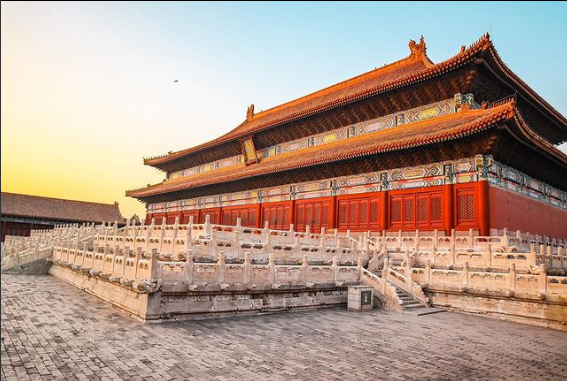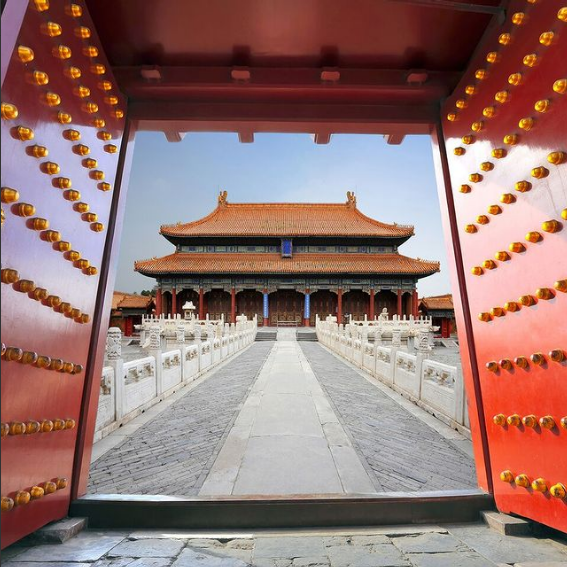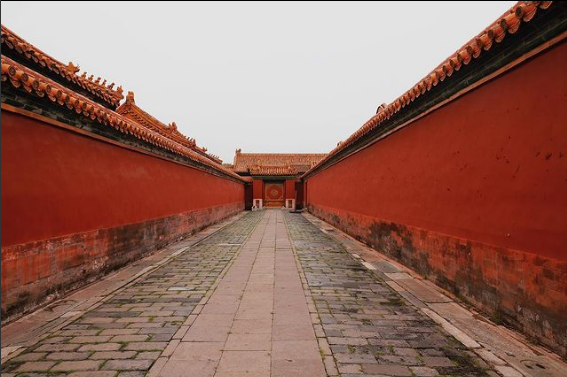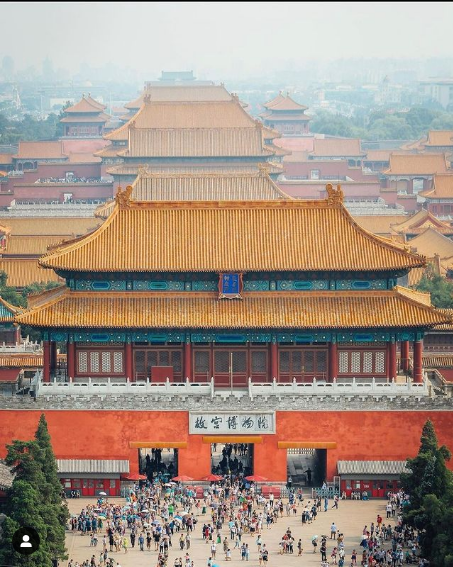Imperial City of China, also known as the Forbidden City, is a monument worth visiting. Located in modern day Beijing, this palace complex has a long history that too few people know about. Impress your friends and maybe prepare yourself with a little knowledge to take with you on a future visit with this article. We’re here to give you a brief “101” rundown on the history of China’s Imperial City, and we’ll even give you a few fun and interesting facts along the way. So sit back and get ready to learn about one of China’s most interesting and lesser known landmarks.

Imperial City of China: A History
China’s Imperial City dates back to the 1400s during the Ming dynasty. While the term city may seem strange, considering it is still standing in the heart of the city of Beijing, just calling it a palace wouldn’t do it justice. It’s actually called a palace construct due to the vast amount of buildings that make up the palace.
It was constructed to be the part time home of the Chinese emperor and served as the epicenter of China’s politics for over 500 years.
Construction of the Imperial City began in 1406. One may think that it would have taken decades to complete at that time. After all, the Duomo in Florence took over 70 years to complete and the Sagrada Familia in Barcelona still isn’t finished. Yet this massive project took less than 20 years before it was ready to be inhabited.
Ming Dynasty- Imperial City in China
The city was the stable base of the Ming dynasty for over two centuries before a rebellion led to the Shun dynasty briefly being in power. This usurping didn’t last long, however, and, while parts of the city were destroyed in the process, the former general of the Ming dynasty army was able to retake control of the empire.
With the Ming dynasty no longer in control, the Manchu people (a minority population in China) was able to take control of enough of China to put their own emperor into power. Thus began the start of the Qing dynasty calling the Imperial City home. This was followed by a period of stability, at least as far as the Imperial City was concerned. However, as can be expected, this general peace for the palace complex did not last indefinitely.
The Opium War of the latter half of the 1800s saw the palace occupied by Anglo-French forces during the last year of the conflict. After which, it was, once again, considered the center of Chinese political power.
End of Imperial City of China as a Center for Power
During the Boxer Rebellion of the turn of the century, the current resident, Empress Dowager Cixi was forced to abandon the city for her safety. With the palace no longer occupied by the ruling power, the rebel army occupied the “city” until a peace treaty was established.
Unfortunately, this marked the beginning of the end for the Imperial City as a center for power within the Chinese territory. 1912 saw the last emperor of China abdicate his role as the head of the country. Though he did not vacate the palace until his eviction over a decade later, the palace was no longer the seat of the political inner workings of China.
Conversion of the Imperial City of China
No longer a residence, the Imperial City was converted into the Palace Museum in the 1920s where the country’s treasures were housed and displayed. That is, until the 1930s when the treasures were removed to keep them safe during the Japanese invasion of China. As is all too common, after all, during times of war, priceless artifacts can go missing after invasions and political occupations.
After the second World War, a number of these artifacts saw their return to the Palace museum, but many were sent to other parts of the country and its territories for safekeeping when the Chinese Civil War seemed to be taking a turn for the worse for the leader at the time, Chiang Kai-shek. The portion of the national treasures that were evacuated from and never returned to the Imperial City palace were kept private until the mid 1960s when they were once again made available for public viewing, this time at the National Palace Museum in Taipei, the capital of Taiwan.
The country-wide revolution that led to the creation of the current People’s Republic of China did also lead to damage to the Imperial City’s structure. Destruction is often a side-effect of revolution, particularly destruction to landmarks that represent old ways of thinking and old political ways of governing that no longer represent what the population wants and is willing to live with. It’s a physical representation of the need and desire for change, as was the case here.
Best Ski Resorts in China 2021
- Yabuli Ski Resort and Spa Resort, Harbin, China
- Zhangjiakou Wanlong Ski Resort Shuanglong Hotel, Zhangjiakou, China
- Yabuli National Forest Park Ski Resort Hotel, Harbin, China
- Yabuli Ski Resort Qingyun Villa, Harbin, China
The Cultural Revolution
The Cultural Revolution that lasted a decade under Mao may have seen further damage done to the palace, if it were not for the forethought of Zhou Enlai, the country’s Premier at the time who ordered troops stand guard to keep the landmark safe.
After the country’s revolutions, the palace was, once again, opened as a museum. In 1987, nearly 600 years after construction first began, the Imperial City was recognized as a World Heritage Site by UNESCO due to its contribution to architecture.
If you visit today, the Imperial city you’ll find is, as stated, largely the Palace Museum which is in charge of the upkeep and day-to-day running of the entire structural complex. A restoration is currently underway to rebuild parts of the city that were rebuilt after 1912 so future visitors will be able to get a sense of what the Imperial City looked like in all its former glory as the seat of Chinese political power.
This is just a brief history of the Imperial City palace. Hopefully it inspires you to look more into it. What does the future have in store for this interesting and complex landmark? We’ll just have to wait and see!
Haven’t had enough of the Imperial city yet? Neither have we, so stick around, we’re not done talking about it just yet!
Imperial City of China : Interesting Facts & Trivia
1) The Palace Museum
The Palace Museum, which is located inside the Forbidden City (the more colloquial term for the Imperial City) is home to nearly 2 million pieces of art, many of which date back to the Ming and Qing dynasties. All of that art is stored in over 900 buildings that sit on nearly 200 acres of land. It’s not your regular small-town museum. Get ready for a lot of walking if you ever have the chance to visit. Pack comfortable shoes and get ready because, palace or not, this may as well be a city for real.
2) It’s Popular-Imperial City of China

According to reports, upwards of 17 million visitors go to see the museum every year with consistent reports of at least 15 million visitors since at least 2012. Those numbers make it more popular than other famous museums around the world such as the Louvre or the MET. With that many visitors, restrictions have even been imposed on how many people are allowed in to see the art and treasures held within the palace walls on a daily basis. Too much foot traffic could lead to the degradation of the structure, and we wouldn’t want that.
3) Honey, I’m Home
While we’ve just mentioned a few names in this article, 24 emperors called the Imperial City home during its 500 year history as an imperial residence. That’s not all. All that room, you can’t expect just the emperors and their families to live on the premises. Anyone under the employ of the imperial family (maids, cooks, and so on) also called the complex home. 980 buildings are tough to fill, you need a town’s worth of people just to keep it running smoothly. Think about that if and when you visit. Just walk around and imagine all the people who once lived where you’re standing.
4) It’s Still (Partially) Forbidden-Imperial City of China
Think you can get free access now that the palace is no longer home to royalty? Think again. In 2017, for example, visitors only got access to 60% of the structure. Due to all the damage that the palace has suffered over the centuries, and just due to its age, much of the Imperial City is being restored and is currently off-limits for visitors. Don’t worry, there’s still more than enough to see to easily spend multiple days visiting, and the Palace Museum hopes to be able to open even more of the structure up to the public in the coming years.
5) No Visa? No Problem!
The Imperial City is located within the heart of Beijing, the Chinese capital. Since 2017 the Chinese government has granted Beijing special “visa-free” status. What does that mean for you? It means that you as a foreigner have 6 days in which you can visit the city without needing a visa of any kind. That includes all the landmarks and monuments that you can find within the city’s limits, the Imperial City included! If you can fight the jet-lag, it’s definitely worth a short trip to take advantage of this little perk!
6) Fly Away, Little Birdie-Imperial City of China
When you visit the Imperial City, you may notice that there are no birds perched on the buildings that make up the palace complex. Weird, right? There are usually one or two birds milling around on buildings, right? The craftsmen and artisans who constructed the palace planned ahead for this. After all, birds landing on the building would lead to more mess to keep clean in order to maintain the palace’s pristine image. The roofs were constructed in a way that would make it difficult, if not impossible, for birds to get purchase and be able to stay put for long.
7) Here, Kitty
Birds may not be welcome guests in the Imperial City, but that doesn’t mean that no animals are allowed. Today you’ll find 100 or more cats calling the Forbidden City home. This isn’t new. Since the palace’s construction, cats have been living within its confines. They were the pets of many of the humans who resided in the palace. While some may be new additions, some of the cats you’ll see roaming around can be traced back to the cats from the Ming and Qing dynasties.
8) Inner and Outer Circles-Imperial City of China
Okay, not so much circles, as courts. The Forbidden city is divided into two courts. The Inner Court and the Outer Court, each with its own functions. You’ll notice the architecture is slightly different in each. The Outer Court was used for public events and ceremonies, during which the emperor needed to seem nearly god-like. In the Outer Court the buildings were imposing to get this point across to anyone not part of the imperial family who attended these events. The Inner Court, while still grand, was reserved as the emperor’s “home” where they could relax without the prying eyes of the public seeing them in a more human and normal state.
9) Rooms with a View
We’ve already told you that the Imperial City complex is made up of nearly 1000 buildings. Well, guess how many rooms there are? If you guessed 10000, you’d be correct. According to reports, there are 9999.5 rooms in the Forbidden City. We were all present when they taught how to round numbers in math, right? That means, by all estimations, there are 10000 rooms. Why the half? 10000 was a sacred and godly number of rooms, and while the emperor was the leader of China, they weren’t quite a deity, thus they weren’t worthy of the full 10000.
10) The Royal Color
When you visit the Imperial City, you’ll notice a lot of yellow. During its construction, this was considered a holy color that dated back to the very beginnings of Chinese culture. Throughout history, yellow slowly became adopted as an official color and eventually became synonymous with the emperor. Thus, when a new palace was constructed to be the imperial residence, yellow was the obvious choice.
11) How Many Men Does it Take?-Imperial City of China
We know that it took 15 years to complete construction on the Imperial City. Which is an impressive feat in itself considering its size. It took over 1 million men to do all that work. A small city worth of people to build the Forbidden City. It makes sense, right? All those men, no wonder it took less than two decades to complete. It’s an architectural marvel on all fronts. Even more so if you consider that the general layout of the palace has remained largely unchanged throughout its history.
12) The Sacred Number
If you get to visit the Imperial City, you may start to notice a particular number pop up time and time again. The number nine was deliberately kept in mind during the design and construction of the palace. In ancient China it was a sacred number and was meant to be a symbol of endurance. Spend some time observing some of the doors around the palace and you’ll notice nine rows of nine nails on many of them. There are 9999 (9999.5!) rooms. Wherever you look, you’ll see a reminder of this number somewhere in the vicinity.
13) Can’t Make it? Not a Problem.
Travel is difficult. There’s a lot to plan and work out. Between finding the time and finding the funds and everything in between, sometimes it’s just too overwhelming. The miracles of technology have got you covered. Sort of. You can take a virtual tour of the Forbidden City from the comfort of your home! There are countless videos you can watch to get a feel for the Imperial palace. Sure, it’s not the same. No one is saying it is, but until travel becomes truly seamless, it’s a good way to scratch that travel itch until you’re able to see it in person!
14) Bigger and Better-Imperial City of China
I think we’ve done a pretty good job getting across the fact that the Imperial City is massive. Did you know, however, that it is the largest imperial palace in the entire world? It isn’t surprising when you consider all the facts we’ve thrown at you about how many rooms and buildings it has and how many men it took to build, but still. The largest palace in the world is an impressive title to hold. If you planned to visit all there is for you to see in one day, think again.
15) Not a Tree in Sight
While you’re in the palace’s outer court, marveling at the architecture and lack of birds, you may notice there aren’t any trees. While the Inner Court has plenty of trees planted, the Outer Court is barren. It’s unknown for sure why, however, it’s possible that trees would have served as a distraction during the ceremonies that were held in the Outer Court. It’s also possible that the lack of tree cover was a strategic decision to help ensure the emperor would be kept safe during said ceremonies. No trees on the public premises would eliminate hiding places for anyone who might wish to harm the emperor.
16) View from the Top
You read all about how big the Imperial City is. You’ve walked inside it and seen how far it stretches. Yet, somehow, you still can’t quite wrap your mind around it. If you want a view of the entire complex all together, then make sure you find time for a visit to Jinshan Park. It’s not part of the Imperial City, however it does allow you a view of the entire palace, so we’re counting that as a fact for this list!
17) Fire!
Don’t panic! We’re just kidding! You know who isn’t kidding around when it comes to fire safety, though? The Palace Museum. The Imperial City is largely made out of wood, so one flame getting out of hand would be disastrous. To combat this there is a truly mind boggling number of fire protection tools around the palace. There are nearly 5000 fire extinguishers and nearly 100 hidden hydrants. There are also 55 fire safety plans in place should they be needed (We hope they never are!). There’s even a designated firefighting team just for the palace.
18) Why Was it Forbidden?
As we’ve said, the Imperial City was and still is also referred to as the Forbidden City. The name conjures up images of folklore and fables. Magic and wonder. Really, the truth is a bit simpler than that. The palace was forbidden…to civilians. It was the home of the emperor! Yes, ceremonies took place in the Outer Court, but it was still largely uncommon for the public to be allowed on the premises. Only the emperor’s family, those in their employ, and their guests were allowed entry.
19) Lights! Camera! Action!
Though it’s an important historical and cultural landmark, that doesn’t mean the Imperial City is closed except for tourism related reasons. Hollywood got to use it as the set for The Last Emperor. You’ll be able to see the familiar architecture in more than a few frames. Aspiring filmmakers, beware. This was a one-time deal. To preserve the structural integrity of the palace, filming, especially on a large scale, isn’t allowed anymore on the property.
20) Why Was it Built?

To finish off our list of facts, we’ll finally tell you why the Imperial City was built. As we mentioned, this was originally a part-time residence for the emperor. The capital of China was, in fact, not always Beijing. The capital was moved during a period of political unrest to keep the emperor safe. The only problem? There wasn’t a suitable palace for the emperor to call home. Thus, construction began. The palace was built to be massive to show off the emperor’s power. It makes sense, right? By building such a huge complex, all the country’s political power is centered in one place, easier to protect, and easier to rule!
After all those facts, we bet you’re planning your trip to the Imperial City right now!
China’s Imperial City, also known as the Forbidden City is a monument worth visiting. Located in modern day Beijing, this palace complex has a long history that too few people know about. Impress your friends and maybe prepare yourself with a little knowledge to take with you on a future visit with this article. We’re here to give you a brief “101” rundown on the history of China’s Imperial City, and we’ll even give you a few fun and interesting facts along the way. So sit back and get ready to learn about one of China’s most interesting and lesser known landmarks.
Recommended Reads
- https://thetravelvirgin.com/does-it-snow-in-china/
- https://thetravelvirgin.com/review-for-air-china/
- https://thetravelvirgin.com/tourist-city-in-mexico-the-best-revealed/
- https://thetravelvirgin.com/agoda-customer-service-number/
- https://thetravelvirgin.com/top-15-virtual-museum-tours-2021-vacationing-at-home/
- https://thetravelvirgin.com/the-best-cities-in-europe/


